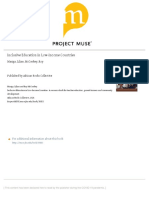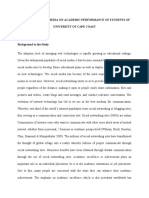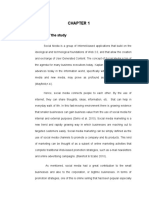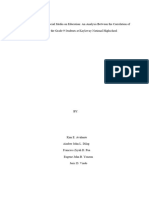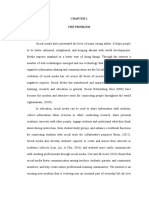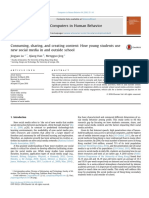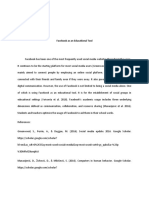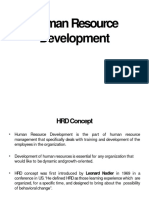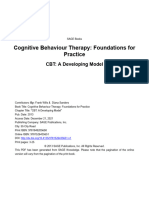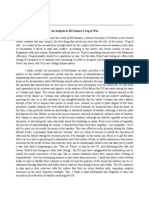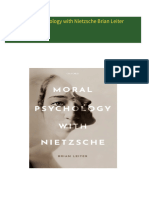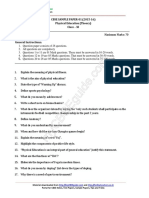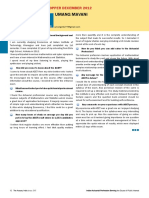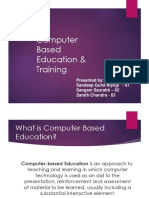References
References
Uploaded by
api-299205777Copyright:
Available Formats
References
References
Uploaded by
api-299205777Original Title
Copyright
Available Formats
Share this document
Did you find this document useful?
Is this content inappropriate?
Copyright:
Available Formats
References
References
Uploaded by
api-299205777Copyright:
Available Formats
BBC Active. (2010). How social media is changing education.
Retrieved from
http://www.bbcactive.com/BBCActiveIdeasandResources/Howsocialmediaisch
angingeducation.aspx
Education Council. (n.d.). New Zealand teachers council: Social media map.
Retrieved from http://teachersandsocialmedia.co.nz/what-social-media
Edudemic. (2015). How to Use Social Media as a Learning Tool. Retrieved from
http://www.edudemic.com/how-to-use-social-media-as-a-learning-tool-in-theclassroom/
Fuchs, C. (2014). Social media: A critical introduction. London, UK: Sage
Publications.
Ihaka, J. (2008, July 10). Online bullying affects 1 in 3 children. NZ Herald.
Retrieved from http://www.nzherald.co.nz/nz/news/article.cfm?
c_id=1&objectid=10520847
Kietzmann, J. H., Hermkens, K., McCarthy, I. P., & Silvestre, B. S. (2011). Social
media? Get serious! Understanding the functional building blocks of social
media. Retrieved from
http://busandadmin.uwinnipeg.ca/silvestrepdfs/PDF06.pdf
Kist, W. (2010). The socially networked classroom: Teaching in the new media age.
Thousand Oaks, CA: Corwin.
Luskin, B. (2012). Brain, behavior, and media: Is media influencing your brain and
your behavior through psychology?. Retrieved from
https://www.psychologytoday.com/blog/the-media-psychologyeffect/201203/brain-behavior-and-media
Marx, K. (1857/ 1858). Grundrise: Foundations of the critique of political
economy. London, UK: Penguin.
McCarthy, J. (2015). 50+ tools for differentiating instruction through social
media. Retrieved from http://www.edutopia.org/blog/differentiatedinstruction-social-media-tools-john-mccarthy
McGee, C., & Fraser, D. (2012). The professional practice of teaching (4th ed.).
Melbourne, Australia: Cengage Learning.
Ministry of Education. (2006). Enabling the 21st century learner: An e-learning action
plan for schools 2006-2010. Wellington, New Zealand: Learning Media.
Ministry of Education. (2007). The New Zealand curriculum. Wellington, New
Zealand: Learning Media.
Ministry of Education. (2015). Social media terms of use. Retrieved from
http://www.education.govt.nz/ministry-of-education/publications/social-mediaterms-of-use/
O'Keeffe, G. S., & Clarke-Pearson, K. (2011). Clinical report: The impact of social
media on children, adolescents, and families. The American Academy of
Pediatrics, 127(4), 800-804. doi: 10.1542/peds.2011-0054
Tester, Z. (2014). Top 5 trends in social media for 2014. Retrieved from
https://www.nzte.govt.nz/en/news-and-media/blogs-andcommentary/2014/1/28/top-5-social-media-tips-for-2014/
Van Brummelen, H. (2009). Walking with God in the classroom: Christian
approaches to teaching and learning (3rd ed.). Colorado Springs, CO:
Purposeful Design.
Villy. (2014). The effects of social media on our body and brain. Retrieved from
http://wersm.com/the-effects-of-social-media-on-our-body-and-brain/
Walpole, J. (2014). How does social media impact your brain and body. Retrieved
from http://theamericangenius.com/social-media/social-media-impact-brainbody/
You might also like
- Clothing Styles in An Intercultural SettingDocument2 pagesClothing Styles in An Intercultural SettingShubhangi AgrawalNo ratings yet
- Fiona Pidgeon 657999x Assessment 1a Essay Scoping Teaching and Learning in 21st Century FinalDocument7 pagesFiona Pidgeon 657999x Assessment 1a Essay Scoping Teaching and Learning in 21st Century Finalapi-248449212100% (1)
- Elearningactionplan 5Document26 pagesElearningactionplan 5api-299205777No ratings yet
- List BibliographyDocument6 pagesList Bibliographyjade tagabNo ratings yet
- Background of The StudyDocument2 pagesBackground of The StudyJUDIE MAE ZULUETA100% (1)
- Pattern of New Media Utilization and Its Influence On Educational Performance Of-3Document38 pagesPattern of New Media Utilization and Its Influence On Educational Performance Of-3Ogunronbi Ademola AkanniNo ratings yet
- The Positive Effect of Social Media On Motivation and Academic Performances of College Students On Electron CollegeDocument62 pagesThe Positive Effect of Social Media On Motivation and Academic Performances of College Students On Electron CollegeChrisha ClorinaNo ratings yet
- Inclusive Education in Low-Income Countries: Mariga, Lilian, Mcconkey, RoyDocument6 pagesInclusive Education in Low-Income Countries: Mariga, Lilian, Mcconkey, RoyJonathanNo ratings yet
- Young Children and Screen Time - Creating A Mindful Approach To Digital Technology - Australian Educational ComputingDocument8 pagesYoung Children and Screen Time - Creating A Mindful Approach To Digital Technology - Australian Educational ComputingPrasangi KodithuwakkuNo ratings yet
- The Problem and Its SettingDocument13 pagesThe Problem and Its SettingFred Ryan Canoy DeañoNo ratings yet
- Review Related LiteratureDocument5 pagesReview Related Literaturejohannes bolinaNo ratings yet
- Chapter 1 Lesson 3Document10 pagesChapter 1 Lesson 3Roselle Ann LizardoNo ratings yet
- CitationsDocument3 pagesCitationsClaudeVladimirNo ratings yet
- 2019 Implication of Social Media in Shs Students of Gnhs 2019Document9 pages2019 Implication of Social Media in Shs Students of Gnhs 2019Anonymous i2VZ0TJaNo ratings yet
- Research Study On Social MediaDocument17 pagesResearch Study On Social MediaJellai Lascamana100% (1)
- Rujukan HighscopeDocument8 pagesRujukan HighscopeTEE YIH CHIANN MoeNo ratings yet
- Itl Research 2012 - Innovative Teaching and Learning Research, 2011 Findings and Implications (Report)Document40 pagesItl Research 2012 - Innovative Teaching and Learning Research, 2011 Findings and Implications (Report)luiz carvalhoNo ratings yet
- Effects of Social MediaDocument5 pagesEffects of Social MediaDanlee EstandaNo ratings yet
- Impact of Social Media On Academic Performance of Students of University of Cape CoastDocument12 pagesImpact of Social Media On Academic Performance of Students of University of Cape CoastKow Asoku NkansahNo ratings yet
- 2.1 Influence of Social Media On Students Academic AchievementDocument10 pages2.1 Influence of Social Media On Students Academic AchievementJessica Patricia FranciscoNo ratings yet
- Practical Research.1Document7 pagesPractical Research.1Christian Dy EspanolaNo ratings yet
- CHAPTER 2 : Knowledge and Attitude of Senior High School Students towards using Social mediaDocument9 pagesCHAPTER 2 : Knowledge and Attitude of Senior High School Students towards using Social mediaEdrian BantogNo ratings yet
- Ej 1227664Document10 pagesEj 1227664mukhtarNo ratings yet
- References 3aDocument2 pagesReferences 3aSassa IndominationNo ratings yet
- Quantifying The Role of Social Media On Education An Analysis Between The Correlation of Social Media To The Selected Students at Kaylaway National Highschool 3Document12 pagesQuantifying The Role of Social Media On Education An Analysis Between The Correlation of Social Media To The Selected Students at Kaylaway National Highschool 3Julius BayagaNo ratings yet
- Chapter 1Document11 pagesChapter 1E.K. ConsultNo ratings yet
- Report EnglishDocument5 pagesReport EnglishAzrul JuraimiNo ratings yet
- 9Document18 pages9FrancisLekololiNo ratings yet
- Eugene InroductionDocument12 pagesEugene InroductionEugeneNo ratings yet
- Looi Cheah Sin 13whr11465 rml3Document9 pagesLooi Cheah Sin 13whr11465 rml3api-260766673No ratings yet
- Lesson 3Document19 pagesLesson 3Clauditte SaladoNo ratings yet
- Last Virsoin of Thesis Project OneDocument82 pagesLast Virsoin of Thesis Project OneOmar MohamedNo ratings yet
- Ijemds v4 2 917Document20 pagesIjemds v4 2 917melsnabzNo ratings yet
- Abosede 1-3Document32 pagesAbosede 1-3Atoba AbiodunNo ratings yet
- Effects of Social To Media To Study Habits (Chaper 1)Document9 pagesEffects of Social To Media To Study Habits (Chaper 1)Kent Joshua Garcia TanganNo ratings yet
- Impact of Social Media-09032023-5Document8 pagesImpact of Social Media-09032023-5uciffjjfffjNo ratings yet
- ReferencesDocument2 pagesReferencesapi-682237653No ratings yet
- The Effects of Social Media To Grade 10 Students Learning and Academic Performance in Bolinao Integrated SchoolDocument31 pagesThe Effects of Social Media To Grade 10 Students Learning and Academic Performance in Bolinao Integrated SchoolToledo, Leah Mae C.No ratings yet
- The Effect of Social Media Exposure On Academic Performance of Senior High School StudentsDocument24 pagesThe Effect of Social Media Exposure On Academic Performance of Senior High School StudentsRuffa Sunga TubigNo ratings yet
- The Impacts of Social Media Usage On Students MentDocument7 pagesThe Impacts of Social Media Usage On Students MentJanaNo ratings yet
- tmpD7D5 TMPDocument10 pagestmpD7D5 TMPFrontiersNo ratings yet
- Abstract Research101Document51 pagesAbstract Research101topfungistNo ratings yet
- Etec 511 Theorizing Educational Assignment 1Document4 pagesEtec 511 Theorizing Educational Assignment 1api-316987303No ratings yet
- Atikwa ProjectDocument49 pagesAtikwa ProjectHenry EgbezorNo ratings yet
- Final Research ProposalDocument10 pagesFinal Research ProposalMahedi HasanNo ratings yet
- Reference List Emt501Document2 pagesReference List Emt501api-252509195No ratings yet
- References For Ela200Document2 pagesReferences For Ela200api-316552871No ratings yet
- Melda Yildiz - Global Kitchen ProjectDocument7 pagesMelda Yildiz - Global Kitchen ProjectClassroom 2.0 BookNo ratings yet
- Research work on Health Institutions in JosDocument56 pagesResearch work on Health Institutions in JosSamuel AndrewNo ratings yet
- Chapter IiDocument37 pagesChapter IiMichaela Jane De LeonNo ratings yet
- The Role of Mass Media As A Socialisation Agent inDocument7 pagesThe Role of Mass Media As A Socialisation Agent innajwa.s.adadaNo ratings yet
- CONTEMPORARYDocument10 pagesCONTEMPORARYkevin sipalayNo ratings yet
- PRACTICAL RESEARCH 2 (SOCIAL MEDIA) ModifiedDocument12 pagesPRACTICAL RESEARCH 2 (SOCIAL MEDIA) ModifiedrhodmharfNo ratings yet
- Positive Effects of Social Media On StudentsDocument2 pagesPositive Effects of Social Media On StudentsVash GoyenaNo ratings yet
- Group 4 - Manuscript NewtonDocument28 pagesGroup 4 - Manuscript NewtonJolo AtieNo ratings yet
- BibliographyDocument3 pagesBibliographyCatherine ValdezNo ratings yet
- Facebook As An Educational ToolDocument5 pagesFacebook As An Educational ToolKashmir RedondoNo ratings yet
- BibliographyDocument8 pagesBibliographyChristian SerranoNo ratings yet
- Full TextDocument25 pagesFull TextCarl Lenard AgcaoiliNo ratings yet
- Developmental Screening TestDocument23 pagesDevelopmental Screening TestSheron Mathew100% (1)
- Zubeda First Draft ThesisDocument96 pagesZubeda First Draft ThesisBereketNo ratings yet
- Human Resource Development Unit 1Document27 pagesHuman Resource Development Unit 1Raj MurthyNo ratings yet
- Reducing Student-Behavior Problems - Notes From A High School Teacher - Education Week Teacher PDFDocument4 pagesReducing Student-Behavior Problems - Notes From A High School Teacher - Education Week Teacher PDFnajihahNo ratings yet
- Tot PresentationDocument56 pagesTot Presentationapi-426946769No ratings yet
- Referee Report: Australian LeadDocument3 pagesReferee Report: Australian Leadptdatbio20140% (1)
- Cognitive Behaviour Therapy Foundations For Practice Third Edition - I96Document17 pagesCognitive Behaviour Therapy Foundations For Practice Third Edition - I96sofiaNo ratings yet
- Art Project RubricDocument1 pageArt Project RubricalisatingNo ratings yet
- Fog of WarDocument1 pageFog of WarRio Jean QuindaraNo ratings yet
- Culture and Organization: Organizational Structure and LeadershipDocument39 pagesCulture and Organization: Organizational Structure and LeadershipSahar Al-Jobury100% (1)
- Quarter 1:week 1 Learners Activity Sheets Mixtures: Science 6Document10 pagesQuarter 1:week 1 Learners Activity Sheets Mixtures: Science 6Pam Cariaga-EbuenNo ratings yet
- PDF Moral Psychology with Nietzsche Brian Leiter downloadDocument47 pagesPDF Moral Psychology with Nietzsche Brian Leiter downloadzhihedeveja100% (1)
- Marketing of Services - Tripti G SharmaDocument6 pagesMarketing of Services - Tripti G SharmaPrakharNo ratings yet
- 2016 SP 11 Physical Education 01Document2 pages2016 SP 11 Physical Education 01Hrithik KumarNo ratings yet
- Conflict ManagementDocument18 pagesConflict ManagementNominee Pareek100% (1)
- DolorDocument8 pagesDolorFelipe DazaNo ratings yet
- ReflectionDocument2 pagesReflectionkaplanfkaplan206239No ratings yet
- LindaDocument50 pagesLindaJude Vincent RicablancaNo ratings yet
- Cover IPCRFDocument18 pagesCover IPCRFtabilinNo ratings yet
- Pornaddiction 131210074623 Phpapp02Document2 pagesPornaddiction 131210074623 Phpapp02indulekharoldantzNo ratings yet
- ACET Topper Interview PDFDocument1 pageACET Topper Interview PDFVijayaNo ratings yet
- Science LPDocument2 pagesScience LPAkiyama NishiNo ratings yet
- Safika Safri (1940601014) - Local B (2019) - ESP - Task 1Document2 pagesSafika Safri (1940601014) - Local B (2019) - ESP - Task 1Safika SafriNo ratings yet
- 5 Facets of Job Satisfaction PDFDocument1 page5 Facets of Job Satisfaction PDFQuang Minh50% (2)
- CBT PPT ECommerceDocument31 pagesCBT PPT ECommerceSandeep Guha NiyogiNo ratings yet
- 2014g pdf2Document83 pages2014g pdf2diegochenkhNo ratings yet
- Connectivism - Emerging Perspectives On Learning, Teaching and Technology"Document5 pagesConnectivism - Emerging Perspectives On Learning, Teaching and Technology"eq3No ratings yet
- Comment: Neuroscientists Must Not Be Afraid To Study ReligionDocument3 pagesComment: Neuroscientists Must Not Be Afraid To Study Religionpauloamuniz3No ratings yet
- Prashant PsychologyDocument11 pagesPrashant PsychologyMohita SuryavanshiNo ratings yet







